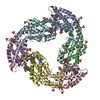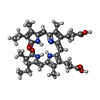+Search query
-Structure paper
| Title | The structure of allophycocyanin B from Synechocystis PCC 6803 reveals the structural basis for the extreme redshift of the terminal emitter in phycobilisomes. |
|---|---|
| Journal, issue, pages | Acta Crystallogr D Biol Crystallogr, Vol. 70, Issue Pt 10, Page 2558-2569, Year 2014 |
| Publish date | Sep 27, 2014 |
 Authors Authors | Pan Pan Peng / Liang Liang Dong / Ya Fang Sun / Xiao Li Zeng / Wen Long Ding / Hugo Scheer / Xiaojing Yang / Kai Hong Zhao /    |
| PubMed Abstract | Allophycocyanin B (AP-B) is one of the two terminal emitters in phycobilisomes, the unique light-harvesting complexes of cyanobacteria and red algae. Its low excitation-energy level and the ...Allophycocyanin B (AP-B) is one of the two terminal emitters in phycobilisomes, the unique light-harvesting complexes of cyanobacteria and red algae. Its low excitation-energy level and the correspondingly redshifted absorption and fluorescence emission play an important role in funnelling excitation energy from the hundreds of chromophores of the extramembraneous phycobilisome to the reaction centres within the photosynthetic membrane. In the absence of crystal structures of these low-abundance terminal emitters, the molecular basis for the extreme redshift and directional energy transfer is largely unknown. Here, the crystal structure of trimeric AP-B [(ApcD/ApcB)3] from Synechocystis sp. PCC 6803 at 1.75 Å resolution is reported. In the crystal lattice, eight trimers of AP-B form a porous, spherical, 48-subunit assembly of 193 Å in diameter with an internal cavity of 1.1 × 10(6) Å(3). While the overall structure of trimeric AP-B is similar to those reported for many other phycobiliprotein trimers, the chromophore pocket of the α-subunit, ApcD, has more bulky residues that tightly pack the phycocyanobilin (PCB). Ring D of the chromophores is further stabilized by close interactions with ApcB from the adjacent monomer. The combined contributions from both subunits render the conjugated rings B, C and D of the PCB in ApcD almost perfectly coplanar. Together with mutagenesis data, it is proposed that the enhanced planarity effectively extends the conjugation system of PCB and leads to the redshifted absorption (λmax = 669 nm) and fluorescence emission (679 nm) of the ApcD chromophore in AP-B, thereby enabling highly efficient energy transfer from the phycobilisome core to the reaction centres. |
 External links External links |  Acta Crystallogr D Biol Crystallogr / Acta Crystallogr D Biol Crystallogr /  PubMed:25286841 / PubMed:25286841 /  PubMed Central PubMed Central |
| Methods | X-ray diffraction |
| Resolution | 1.751 Å |
| Structure data |  PDB-4po5: |
| Chemicals |  ChemComp-CYC:  ChemComp-SO4:  ChemComp-HOH: |
| Source |
|
 Keywords Keywords |  PHOTOSYNTHESIS / alpha-helical phycobiliprotein / light harvesting / PHOTOSYNTHESIS / alpha-helical phycobiliprotein / light harvesting /  phycocyanobilin / methylation on Asn71 in ApcB subunit / phycocyanobilin / methylation on Asn71 in ApcB subunit /  phycobilisome phycobilisome |
 Movie
Movie Controller
Controller Structure viewers
Structure viewers About Yorodumi Papers
About Yorodumi Papers




